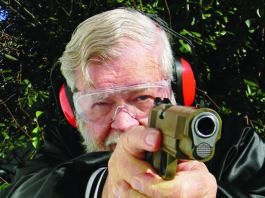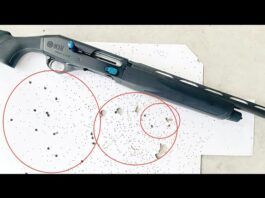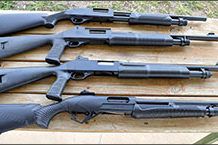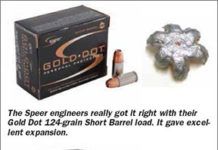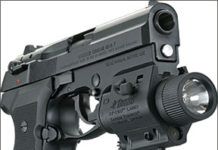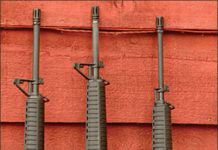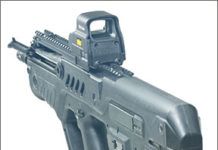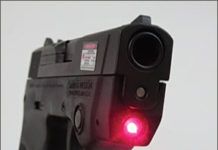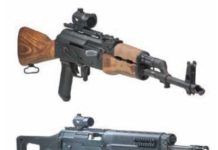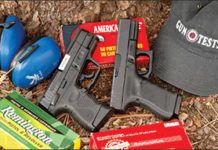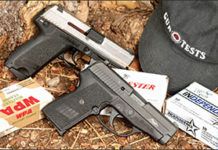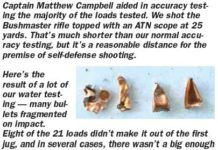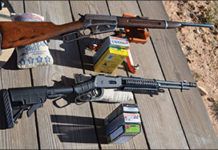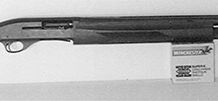Affordable Defense Shotguns: Benelli, Stevens, CZ Compete
Unlike the conflicts with bad guys depicted on television and in the movies, a home owner in a self-defense situation will rarely fire more than one or two shots. In most cases, the owner of a firearm specifically designed to stop the threat of an intruder will never fire even one shot in their home because they will never be put in such a position.
With the caveat that there might be a slight possibility of a zombie apocalypse or another type of breakdown of society, most self-defense shotgun owners are simply looking for a little peace of mind and a lot of confidence that their firearm will perform in a capable manner when and if it is required.
Nevertheless, it is also a fact that self-defense shotguns have been and continue to be a very popular item in the firearms market. Models from basic slide-actions that have been slightly modified from their field version counterparts to highly adapted tools designed to meet the extreme needs of law enforcement and military users are among the available offerings.
At a reader's request, we selected several new models of self-defense shotguns that carry low to moderate price tags and pitted them against one of the popular veteran self-defense shotguns to see how they would perform. The 12-gauge pumpguns in our test included the Benelli Super Nova Tactical No. 29155 pump-action 12 Gauge, $559, which has been a self-defense staple for years, and the recently introduced Stevens Model 320 Home Defense No. 19495, $270; the CZ Model 612 Home Defense No. 06520, $290; and the CZ Model 612 HC-P No. 06510, $349.
All of the short-barreled pump-action shotguns are designed for a specific need and purpose — self defense — and do not easily lend themselves to other uses, such as hunting in the field or busting clay targets.
As one veteran gunsmith in our group noted: "Most of these shotguns will not have a box of shells fired through them in a year and a lot won't have more than a half-dozen boxes shot in them during a lifetime."
With this truism in mind, we limited our field testing of the four shotguns to firing at paper targets on the range and did not attempt any evaluation of how the shotguns would handle clay targets or birds in the air. These self-defense firearms are designed to be fired more like a rifle than a scattergun, so it would be unfair to judge them on the qualities found in high-dollar, better-balanced firearms that have a place in the field and on clay-target ranges.
Sticking with the types of ammunition that would handle most self-defense situations, we put the four shotguns through patterning and performance tests with a variety of shotgun shells. The ammo selection in our shooting bag included Remington ShurShot Heavy Dove 2.75-inch loads packing 1.125 ounces of No. 6 shot with an average muzzle velocity of 1,255 fps; Federal Power-Shok 2.75-inch loads with 27 pellets of No. 4 buckshot and an average muzzle velocity of 1,325 fps; and Winchester Super-X 2.75-inch 1-ounce rifled hollowpoint slugs with an average muzzle velocity of 1,600 fps.
When putting patterns on paper, we utilized the recently introduced Birchwood Casey Eze-Scorer 12x18-inch Transtar Blue and BC27 Green Silhouette Targets and the 23x35-inch Bad Guy, all on non-reactive paper. The targets, set at ranges of no more than 20 feet (typical of a home-defense situation), allowed us to realistically and effectively evaluate the performance of the test shotguns. We fired the Federal Power-Shot No. 4 buckshot at two targets, first at the Birchwood Casey Bad Guy set downrange at 20 feet and then at the Birchwood Casey Transtar Blue or BC27 Green Silhouettes about 10 feet to the side of the Bad Guy. The Remington ShurShot No. 6 shot was fired at the chest and head area of the Bad Guy targets, followed by a Winchester Super-X slug as a head shot.
It should be noted that all of the ammunition fired in the short-barreled shotguns produced quite a punch on both ends. These are not the type of firearms designed for extensive time on the firing range unless the shooter is immune from recoil. For the sake of our shoulders, a few rounds fired with each variety of ammunition were all that we deemed necessary for our evaluation. Here are the test results:
9mm Short-Barrel Choice: Wed Carry 124-Grain Speer Gold Dots
Turkish Pistol Shootout, Round Two: TriStar Versus Stoeger
When comparing handguns for Gun Tests, there is a bottom line. That bottom line is reliability and acceptable accuracy. If the pistol isn't accurate enough for personal defense, or if the piece isn't reliable, then it doesn't earn a passing grade. That is the baseline. Next, we look for above-average accuracy as a tie breaker. The next consideration is handling. When it comes to a personal-defense handgun then, the heft, balance, feel, and how these factors interact to allow the handgun to come to target quickly are very important. Anyone can make a handle feel like a 2-by-4, but only true craftsmen understand the subtleties of grip design and how to make a gun feel right. But with a bit of careful design and a study of ergonomics, you might just find a shape that fits most hands well. The rub is, this may be difficult when the shooter also demands a magazine capacity of 13 rounds or more. This makes designing a handgun with comfortable hand size more difficult.
We say all this as an introduction to a second test of handguns from Turkish companies to follow up on our July match up. TriStar Sporting Arms imports the Canik 55-made T-100 No. 85110 9mm Luger, which sells for $439. Stoeger itself makes the Cougar 8000F No. 31700 9mm Luger, $449, in Turkey. The companies did not design either of these handguns, but they are producing them, and the pistols are built upon proven patterns. Just the same, there is much to recommend in either handgun and much that differs as well.
The differences in opinions among the raters were interesting as well, and in some cases profound. Our rater with the most military experience is a military intelligence officer who often sees the big picture. According to him, the pistols are tactically equal. There isn't anything that could be done with one compact high-capacity 9mm that couldn't be done with the other pistol. There is some merit in that supposition. Just the same, he came to lean toward the Cougar because it was most like his issue Beretta. Another rater who prefers the 1911 handgun for most uses found the CZ 75 system in the T-100 favorable. He felt that the Cougar was more technical than tactical. And so it went. One pistol is possibly better suited to all around service or as a belt pistol, while another may be better suited for concealed carry.
Another question might be how each compares to the original they are copied from. How does the Stoeger Cougar compare to the Beretta Cougar, now out of production? Well, if you like the Cougar, it is either the used market or the Stoeger. If you like the CZ 75, there is the original and many clones or copies. So, we had many questions to answer. And with all due respect to our military rater, though the pistols are tactically equal, the differences in handling and favored features are substantial. The opinions of experienced raters are particularly valuable in this case. This isn't simply a comparison of two Turkish-produced pistols, but rather a significant look into double-action and selective double-action pistols.
Rock River Arms, ArmaLite, and Bushmaster AR-15s Compete
Tavor TAR-21: Bullpup Takes a Licking, Keeps On Kicking
Follow Up: 380 Pocket Pistols With Factory-Fitted Lasers
CIA Against Sig Sauer: AK-47 Takes On AK-47 Compatible
With all of the political focus on guns, and specifically semiauto AR-style rifles, shooting enthusiasts have been trying to get their hands on products that are durable enough to last through any of the troubles that might be coming. For this task, the AK-47 platform may be the best place to start. Known for durability and reliability, the AK-47 has been tagged "the rifle of the revolution." If you have ever seen a movie that has bad guys in it, you have probably seen them carrying a AK-47. There are videos all over the internet of people doing crazy things with their AKs, such as shooting them in pools, firing so many rounds through them at a fast enough pace to set the front end on fire, burying them and pulling them out of the ground and firing them, and the list goes on and on.
[IMGCAP(1)]
We picked out two vastly different AK-style rifles for a head-to-head Gun Tests showdown: The WASR-10 imported by Century International Arms and the 556 Russian (556R) made by Sig Sauer. At first glance, the Century International Arms WASR-10 7.62x39mm, $900 (online pricing from GanderMountain.com), looks like a classic AK design, but it has some refinements American shooters will prefer. The WASR-10 is a post-ban version of the AKM rifle. WASR stands for Wassenaar Arrangement Semiautomatic Rifle. The name comes from a Dutch town where the international agreement on exportation of small arms was born. As manufactured in Romania, the 7.62x39 mm GP WASR-10 accepts single-column 10-round magazines. At the Century International Arms factory, the rifles are modified to conform with Title 18, Chapter 44, Section 922(r) of the United States Code. After arriving in the U.S., the rifles are disassembled, the magazine wells are machined out to accept double-stack magazines, and the requisite number of U.S.-made parts are installed for BATF compliance. With enough domestic parts included to make it "officially" U.S. made, the rifle can have a pistol grip and accept high-capacity magazines. The added U.S. parts are: 1) gas piston, 2) trigger, 3) hammer, 4) disconnector, 5) buttstock, and 6) pistol grip. Some units also have Tapco plastic folding or collapsible stocks. Beginning in 2007, Century International Arms has installed the Tapco Intrafuse AK G2 trigger group to eliminate trigger slap. These rifles come supplied with two 30-round magazines and a bayonet lug.
In contrast, the mostly polymer 556R looks like something out of a science-fiction movie. The Sig 556R is a revised version of the original rifle chambered in 7.62x39mm, most commonly referred to as the Gen 1. While there was never an official recall announced by Sig, the company will stand by the Gen 1 gun and make the corrections needed to get the gun up to par. One of the ways that you know whether you have a Gen 1 or a Gen 2 is that the Gen 2 has a steel-reinforced magazine shelf. One of the Gen 1's problems was that metal magazines commonly used with AK-47s would wear down this shelf over time and cause the magazine not to sit correctly, or in some cases not even stay seated in the magazine well. Another issue that a lot of users reported were failures to eject. If you compare the size of the ejection port on the Gen 1 next to a Gen 2, you will notice that the Gen 2 has a much wider opening, allowing shells to eject without catching and causing a problem. The final issue on Gen 1s that owners reported were failures to fire. To solve this in the Gen 2s, Sig apparently increased the hammer-spring strength to make sure the harder primers in Russian ammo would ignite.
The good news is this: when Sig fixes a problem, they really fix it. The Sig 556R that we used in this test has all of the modifications already made, and it is just as reliable as every other AK out there, we believe. With its hefty price tag (going for nearly $3000 in some listings early in 2013), we wanted to see if the Sig was worth the money, or if the handy shooter is better off buying a less expensive model like the WASR-10 and making his own adjustments as time and necessity require and money allows. Here's what we thought of the two rifles compared point by point:
Two Midsize 40 S&W Pistols: Taurus and Glock Square Off
Midsize Nine Carryables: H&K Competes Against Sig Sauer
Testing 223 Remington Rounds For Personal-Defense Use
Space Age versus Old Age: We Compare Two Lever Actions
For some shooters, Hollywood seems to have become a prime factor in choosing the style and type of firearm finding favor on the range and in the field. This truism seems to be particularly prevalent when dealing with lever-action rifles. In the old days, Westerns ruled the movie screens and a true-blue cowboy had three good companions - "my rifle, my pony and me" - as sung by Dean Martin in the classic western Rio Bravo.
One of those good companions for quite a few cowboys and hunters of that time period was the Winchester Model 1895. The Model 1895 was the first Winchester rifle to feature a box magazine located underneath the action instead of the tubular magazine design, allowing for the use of military and hunting cartridges with pointed bullets, and was the last lever-action rifle to be designed by legendary gunsmith and inventor John M. Browning. For our test, we were able to obtain a vintage Model 1985 in 30-40 Krag that dates back to the early 1900s, when it sold for a mere $25. The specific firearm we used in the test had spent countless hours in a rifle scabbard on horseback or on the side of a truck bouncing through the South Texas brush near Laredo and has accounted for more jack rabbits, coyotes and whitetail deer than can easily be counted.
On the more modern side of the Hollywood depiction of a lever-action shooter is the recently introduced Mossberg Model 464 ZMB 30-30 Win., offering a variety of high-tech features to handle the highly promoted zombie apocalypse. Short and quick with the ability to add all kinds of optics and lights for effective firepower to stop the undead — if they ever make their appearance — or varmints and deer-sized big game, the Mossberg has upgraded the lever-action rifle to a space-age weapon.
Although the calibers are identical — the 30-40 Krag is also known as the 30 U.S. — the Krag provides a little more punch with a larger bullet than the 30-30 Win. Both cartridges are considered prime brush guns for handling small game up to animals the size of a whitetail deer at ranges of 100 yards or less.
It should be noted that while quite a few rifle cartridges are hard to find with the ongoing high ammo demand, the 30-30 rounds are generally easier to obtain than the veteran 30-40 Krag. We were able to obtain three varieties of 30-30 (including the specially marketed Hornady Zombie Max designed for use on the undead) and two brands of 30-40 Krag for our tests. Here's our report:
Fixing The S&W/Mossberg Model 1000
Many people still shoot the S&W/Mossberg Model 1000, but it may require your attention. Here are the basics of getting this autoloader operational again.





























